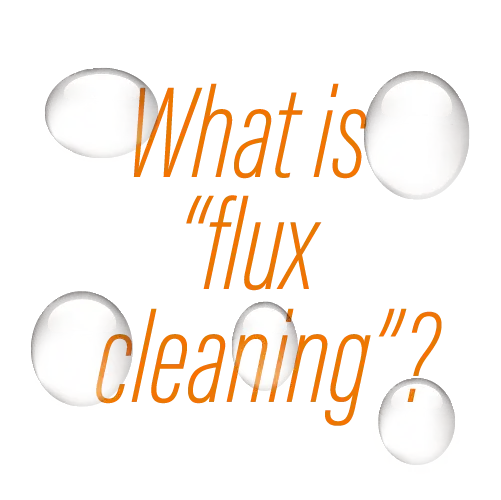- Company
- Products
- Technical report
- Indusrial cleaning
- Micro Joining and Assembly Technology
- Ultrasonic technology
- Trouble solution
- Cleaning
- Removing
- Attaching
- PCB Columns
Published on :
Flux, often heard of in the soldering (soldering) process of mounting, is a soldering aid and is responsible for enabling the soldering.
| ▽▼Click here for the page explaining "What is flux?"▼▽ | |
 |
PCB Mounting Columns
|
|---|---|
In this article, we will explain what flux residue left after soldering is, and the problems caused by flux residue and their countermeasures.
Flux residue is like flux burnt off after soldering and contains rosin, unreacted activators, thixotropes, and metal salts (such as Sn salts).
The rosin, activator, and other components of flux react with the oxide film on the metal surface during the soldering process to dissolve and remove the oxide, enabling soldering. However, "flux residue" (burnt residue after the reaction) is produced at the same time as the soldering completes.
If this flux residue is left unattended, there is a risk that the activators and rosin in the flux residue will corrode metals, or that the reactants in flux and the oxide film will absorb moisture in the air and cause problems. Other physical problems can also be caused by the presence of flux residue.
Ionic substances such as metallic salts contained in flux residue become electrolyte solutions in humid environments and can precipitate metals between leads of mounted components due to ion migration, causing circuit shorts.
Ionic substances such as metallic salts contained in flux residues are conductive in humid environments and may cause corrosion when voltage is applied. Even in the absence of voltage, galvanic corrosion may occur when dissimilar metals come in contact.
Flux residue is highly insulating when dry, so if it adheres to the contact points of a connector mounted as a component, for example, it will cause a poor connection.
During in-circuit testing (ICT) and function testing, if contact pins become contaminated with flux residue, contact failure occurs, reducing inspection efficiency and reliability.
If the soldering area is covered with flux residue, it will reflect glitter and interfere with visual observation of the soldering condition (solder surface condition, shape, etc.).
In addition, it may cause wire bonding connection failures and encapsulating resin (underfill, etc.) hardening and filling failures in the post‐process as well.
There are a variety of problems ranging from discoloration in appearance to problems that can destroy the functionality of the product. If products are shipped with flux residues remaining that can cause these problems, there is a risk of major market problems!
Cleaning (called flux cleaning or defluxing) is extremely effective in solving or preventing problems caused by flux residue.
When low-residue or no-clean flux is used, there are cases where the flux cleaning process is omitted. However, in fields where high reliability is required, such as automotive modules and space-related equipment, the flux residue cleaning process is essential to avoid the problems described above.
In addition, recently, in fields such as IT where high-density mounting is accelerating, even a small amount of flux residue may cause dielectric loss (adverse effect on circuit characteristics) due to residual resin in flux residue, and flux cleaning is required.
So what are the specific cleaning methods?
See "Tips on Flux Cleaning"!
 |
Trouble solution
|
|---|
Standard Micro Soldering Technology, 3rd Edition
Japan Welding Engineering Society, Micro Soldering Education Committee [ed.]
Nikkan Kogyo Shimbun
KAKEN TECH, MICROCLEANER, MICROCLEAN&MARKLESS and MARKLESS are trademarks of KAKEN TECH CO., LTD. in PRC.
KAKEN TECH is a trademark of KAKEN TECH CO., LTD. in the U.S..
| Inquiry |